|
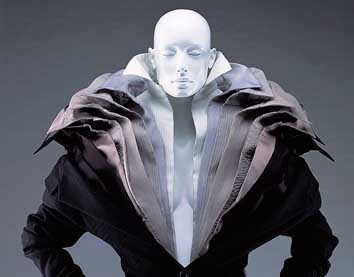
 S WE ENTER the new Dark Ages ('Black
is the new black for fall 2005—and spring 2006!'), it's never
a better time to fully explore our relationship with colour in fashion
and how it has evolved over hundreds of years. Starting December
9, 2005 through March 26, 2006, the Smithsonian's Cooper–Hewitt,
National Design Museum (2 East 91st Street, New York, NY
10128, www.cooperhewitt.org),
will present Fashion in Colors, an exhibition that will explore
the use of colour as a design element through 300 years of western
fashion, as well as examining its ever-changing
S WE ENTER the new Dark Ages ('Black
is the new black for fall 2005—and spring 2006!'), it's never
a better time to fully explore our relationship with colour in fashion
and how it has evolved over hundreds of years. Starting December
9, 2005 through March 26, 2006, the Smithsonian's Cooper–Hewitt,
National Design Museum (2 East 91st Street, New York, NY
10128, www.cooperhewitt.org),
will present Fashion in Colors, an exhibition that will explore
the use of colour as a design element through 300 years of western
fashion, as well as examining its ever-changing 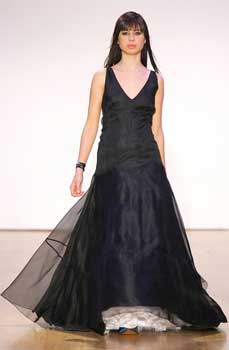 perceptions
through various ages and cultures. perceptions
through various ages and cultures.
Initially organized by the Kyoto Costume Institute
(KCI) Japan, the exhibition draws
from the Institute's collection of nearly 11,000 western-style dresses
and other garments to highlight more than 60 historical and contemporary
designs dating from the 18th century to the present, and will be
on view on the first and second floors of the Cooper–Hewitt with
costumed mannequins installed according to six separate colour-saturated
schemes—black, multicolour, blue, red, yellow and white—to
emphasize and highlight the cultural, spiritual and social associations
linked with each colour.
‘Fashion in Colors,’ said Cooper–Hewitt
director, Paul Warwick Thompson, ‘presents a distinctive interpretation
of colour in design and its impact on culture, trade and taste.
We're delighted that Fashion in Colors will make its international
début at Cooper–Hewitt, particularly as this is the largest
fashion-oriented design exhibition held at the museum.’
Exhibition highlights include modern and contemporary
masterpieces by Gabrielle 'Coco' Chanel, Christian Dior, Viktor
& Rolf, Elsa Schiaparelli, Vivienne Westwood, Dolce and Gabbana,
Junya Watanabe, Emilio Pucci, Cristobal Balanciaga, Rei Kawakubo/Commes
des Garçons, along with historical costumes, including late-18th-century
gowns and late-19th-century bustle-style dresses.
Fashion in Colors examines the ever-shifting
relationship between different hues, feelings and functions and
‘is a dramatic and thought-provoking examination of fashion
and form through the language of colour,’ said Cooper–Hewitt's
Curatorial Director Barbara Bloemink. ‘The exhibition mirrors
the museum's mission of viewing the history of design through 21st-century
eyes.’
The exhibition's Black section delves into our
notions of black as a symbol of modernity and elegance, as well
as its reputation as the sombre colour of mourning in the west.
Coco Chanel's "little black dress" of the 1920s still
serves as the epitome of simple elegance even today; while Viktor
& Rolf's elaborate multi-collared jacket and pant set from 2003
aptly demonstrate how much creativity one can be squeezed out of
what is still significantly known as funeral garb—even if it
is a sea of black on the steps of the Bryant Park Tents for the
Olympus New York Fashion Week shows and there's not a hearse or
weeping widow in sight.
Patchwork and multicolour designs have never
been more in 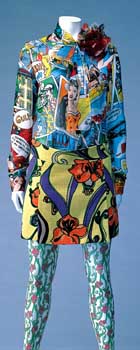 style,
as seen on the runways for the spring 2006 shows (witness Chado
Ralph Rucci's black maze velvet coat and boots from his fall 2005
haute couture collection and Strenesse's double-layered taffeta
flower print dress with pleated chiffon hemline from Gabriele Strehle).
The Multicolour section will feature fantastical designs (both casual
and formal) that undeniably blurred the line between art and clothing
from some of the biggest names in design of the late 20th century:
Vivienne Westwood (a multilayered tutu skirt from 1993), Dolce and
Gabbana (2004's polychrome cartoon-motif printed silk shirt; cotton–linen
blend miniskirt with floral print and Technicolor hosiery) and Viktor
& Rolf's cotton–satin Harlequin jacket and pants (1998)
from the Collection of the Gröninger Museum. style,
as seen on the runways for the spring 2006 shows (witness Chado
Ralph Rucci's black maze velvet coat and boots from his fall 2005
haute couture collection and Strenesse's double-layered taffeta
flower print dress with pleated chiffon hemline from Gabriele Strehle).
The Multicolour section will feature fantastical designs (both casual
and formal) that undeniably blurred the line between art and clothing
from some of the biggest names in design of the late 20th century:
Vivienne Westwood (a multilayered tutu skirt from 1993), Dolce and
Gabbana (2004's polychrome cartoon-motif printed silk shirt; cotton–linen
blend miniskirt with floral print and Technicolor hosiery) and Viktor
& Rolf's cotton–satin Harlequin jacket and pants (1998)
from the Collection of the Gröninger Museum.
CONTINUED

|
 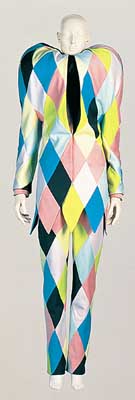 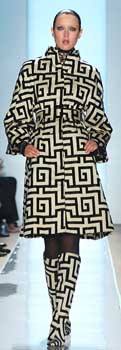  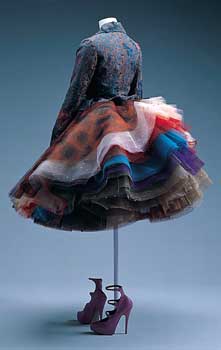
LEFT COLUMN: Viktor
& Rolf jacket and pants, 2003. INSET:
Morgane & Fay spring 2006. LEFT:
Dolce & Gabbana shirt, skirt and hose.
ABOVE, FROM TOP: Chanel day dress, c. 1927. Viktor &
Rolf Harlequin jacket and pants, 1998. Chado Ralph Rucci couture,
fall 2005. Strenesse by Gabriele Strehle, spring 2006. Vivienne
Westwood jacket and skirt, 1993. BELOW:
Multicolour room, National Museum of Modern Art, Kyoto, 2005.
|
 Read
more in the November 2005 issue of Lucire. Read
more in the November 2005 issue of Lucire.
To make sure you don’t miss out, click
on the image at right to subscribe
or purchase a single copy. (Click 'Yes' if pop-up boxes appear—you're
being switched to our secure server and it is completely safe.)
|
|

